Contents
Market Overview
Macro Review
A strong non-farm payroll (NFP) didn’t support a higher USD. Stronger payrolls were expected, but cracks emerged as unemployment rose to 3.7% and average hourly earnings weakened. It would seem the Fed has some breathing room before the next CPI release. However, a more expedient approach from the ECB is necessary with the need to hike rates by 75bp in order to maintain credibility. Eurozone inflation hit 9.1%, but there could be some downside risks as European gas prices eased on fiscal initiatives. Indeed, the credibility catch-up remains a theme after Powell’s hawkish comments at Jackson Hole. The slump in JPY to a 24-year low comes just as GBP is targeting lows not seen since 1985. The bearish UK view is premised on recession risks, soaring inflation, dependence on foreign capital and a BoE mandate that is set to be circumscribed. The political paralysis ought to be partly unlocked as the UK will soon announce its new Prime Minister on Monday, which will see Boris Johnson officially resign on Tuesday at the Queen’s estate in Balmoral. In spite of a stronger USD over the week, we saw EM across FX, rates and credit outperform developed markets, but equities remained weak (S&P -5.5%) and crude oil languished (-6.3%). In fact, oil is on its longest monthly losing streak since 2020 (-9% in August), as growth concerns rise, an Iranian nuclear agreement becomes increasingly realistic and the G7 introduced a cap on Russian oil prices. Both the iTraxx Xover and CDX HY (US HY) indices widened 8bp and 13bp, respectively, while EM outperformed as CDX EM tightened 4bp. The High Yield segment of the market within EM generally held up better than Investment Grade, in part as US Treasuries widened some 9-19bp. The weakness in Europe looked more contained as German bunds were only 8-14bp wider, but the frantic and volatile moves in the 2-year segment of the curve stood out (more so in the UK gilt curve that widened 28bp). PMI trends were generally upbeat as China’s Caixin Manufacturing reading was steady, just as South Africa’s vastly recovered. This helped offset the surprising slump in South Korean and Taiwanese PMIs. We would also note that Indonesia’s upbeat PMI of 51.7, came with headline inflation retreating from 4.94% to 4.69%. South Africa’s PMI of 52.1 was driven by higher business activity which rose from 39.8 to 50.6, just as business conditions improved from 49.4 to 57.9 and purchasing commitments rose from 45.4 to 54.9. Elsewhere, we had IMF updates and release of proceeds to Pakistan ($1.16bn under EFF), Sri Lanka ($2.9bn under EFF) and Zambia ($1.3bn under ECF).
EM Credit Update
Emerging market sovereign credit ended the week down 2.4% with spreads 19bp wider. Outperformers over the week were Sri Lanka, El Salvador and Namibia while Ukraine, Ghana and Ethiopia underperformed. In an unfortunate turn of events, Argentina decreed a national holiday on Friday after the assassination attempt on Vice President Cristina Fernandez de Kirchner. Separately, ISDA announced that the Russian CDS auction will take place on September 12.
The Week Ahead
Aside from Labor Day, the ECB meeting is the main fixture next week. Then in spite of mixed Chinese Manufacturing PMIs there is an expectation of weaker export growth and factory output, where Caixin Service PMIs are also due. Also on Monday, OPEC+ will meet where there is speculation of a production cut as Saudi Arabian officials recently floated the idea and could stem the rout lower in crude. The resumption of Nord Stream 1 gas flows to Europe will also be closely watched. The same can be said of the Chilean constitutional reform referendum. As for EM interest rate decision, Kazakhstan (14.5%), Malaysia (2.25%), Poland (6.5%) and Ukraine (25%) stand out. Inflation releases are also due out of Brazil, Chile, Colombia, Ecuador, Mexico, Philippines, Thailand, and Turkey. Turkish inflation stands out, just as the Istanbul reading came in at 99.9% last Thursday, but also as electricity for residential and commercial tariffs were raised by 20% and 50%, respectively. Finally, Apple will unveil the new iPhone 14.
Highlights from emerging markets discussed below include: Sri Lanka and Zambia make progress in securing IMF financial support; Chile secures $18.5 billion IMF Flexible Credit Line (FCL) as it heads into referendum on new constitution; Pakistan’s IMF program resumes just as a third of the country is devastated by catastrophic floods
Fixed Income
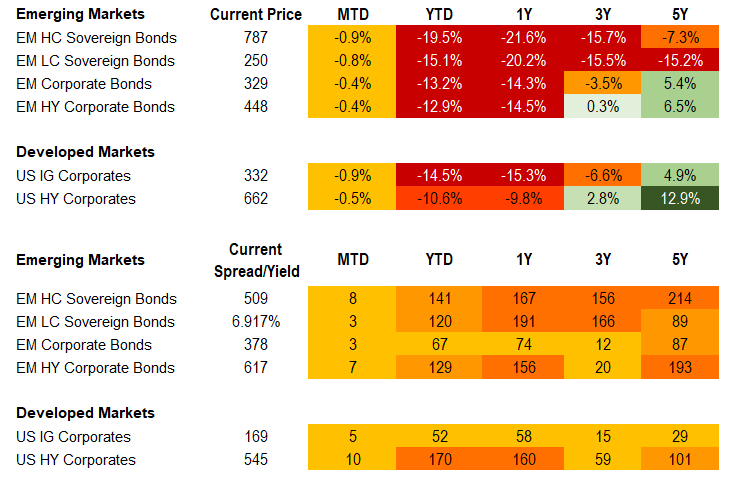
Equities
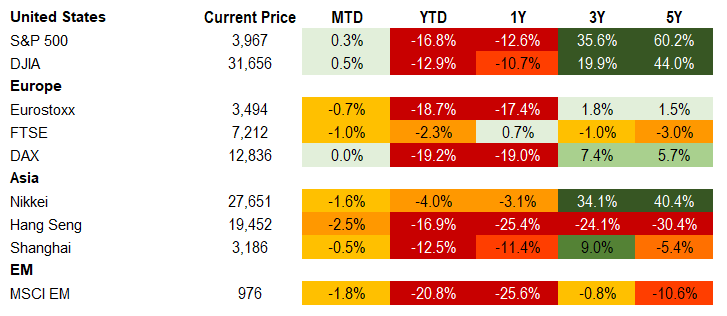
Commodities

Source for data tables: Bloomberg, JPMorgan, Gramercy. EM Fixed Income is represented by the following JPMorgan Indicies: EMBI Global, GBI-EM Global Diversified, CEMBI Broad Diversified and CEMBI Broad High Yield. DM Fixed Income is represented by the JPMorgan JULI Total Return Index and Domestic High Yield Index. Fixed Income, Equity and Commodity data is as of September 2, 2022 (mid-afternoon).
Emerging Markets Weekly Highlights
Sri Lanka and Zambia make progress in securing IMF financial support
Event: On Thursday, IMF staff and the Sri Lankan authorities reached a staff-level agreement (SLA) to support Sri Lanka’s economic adjustment with a 48-month Extended Fund Facility (EFF) of about $2.9 billion. A day earlier, IMF’s Executive Board approved a 38-month Extended Credit Facility (ECF) for Zambia of around $1.3 billion, equivalent to 100% of Zambia’s IMF quota. Zambia had achieved a SLA with the IMF in December 2021.
Gramercy commentary: These developments represent credit-positive steps for distressed sovereigns. In 2020, Zambia became one of the first pandemic-era emerging markets sovereign defaulters when the government asked for a debt moratorium and initiated a restructuring process under the guidelines of the G20’s so called “Common Framework” that brings together official sector creditors from the Paris Club (developed markets creditor nations) and China. In that context, successful implementation of the new ECF arrangement is subject to Zambia securing timely restructuring agreements with external creditors. Sri Lanka, whose government formally defaulted and requested IMF assistance in July 2022, is facing a similar set of challenges in terms of negotiating with bi-lateral and private creditors. While reaching the SLA was a critically important step on the way to securing IMF funding and restoring debt sustainability, the Sri Lankan authorities still need to achieve significant progress before IMF disbursements materialize. The Fund has made it clear that financing assurances to restore debt sustainability from Sri Lanka’s official creditors (China, India and Japan being the largest ones) and making a good faith effort to reach a collaborative agreement with private creditors are crucial before the IMF can deem Sri Lanka’s sovereign debt sustainable and provide financial support.
Chile secures $18.5 billion IMF Flexible Credit Line (FCL) as it heads into referendum on new constitution
Event: On Monday, the IMF approved a two-year FCL for Chile worth $18.5 billion. This coming Sunday, September 4, a referendum will decide whether a new constitution for the country, being drafted by an elected Constitutional Convention since May 2021, will be approved, or rejected.
Gramercy commentary: According to the latest polls, it appears the more likely outcome of Sunday’s plebiscite will be to reject the proposed new constitution intended to replace the existing Pinochet-era charter. In the case of a rejection, we expect a mixed impact from a market perspective. On one hand, the proposed new constitution implies a structural increase in government spending and participation in economic affairs, so markets are likely to react positively to its potential rejection by voters. On the other, a rejection would mean a major political defeat for President Boric who has thrown his political support behind the new constitution. As such, if Chileans vote to reject the constitutional proposal, this would be another heavy political blow to the Boric Administration, which has already seen a significant decline in their approval ratings and will likely face even stronger governance and policy-implementation challenges in that scenario. Against this complicated domestic political backdrop and significant global macro cross currents, the $18.5 billion FCL from the IMF provides a welcome support to Chile’s external accounts. It comes at a time when the economy is struggling with record high Current Account (CA) deficits, weakness in Chile’s main commodities export market with China, and pressure on FX reserves amid the Central Bank’s $25 billion FX intervention program initiated in July. In this context, we expect the FCL to reduce pressure on Chile’s FX/sovereign credit but not drive a sustained rally in the near-term, given a variety of meaningful headwinds.
Pakistan’s IMF program resumes just as a third of the country is devastated by catastrophic floods
Event: IMF’s Executive Board completed the combined seventh and eighth reviews under Pakistan’s Extended Fund Facility (EFF), allowing the authorities to draw about $1.1 billion. Meanwhile, the country has been hit by unprecedented rainfall and flooding that has affected more than 30 million of Pakistan’s 220 million population, devastated large swaths of territory, and killed at least 1,100 people.
Gramercy commentary: The news about the conclusion of IMF reviews and resumption of financial assistance under Pakistan’s existing program has been keenly anticipated by markets as it is expected to provide critical relief to the government that has been reeling with a series of economic and political setbacks in recent months. The resumption of the IMF program is likely to catalyze further financial inflows from bilateral sources that should help avoid sovereign debt distress, at least in the near-term. Over the medium-term horizon, the outlook seems more challenging, especially as the country has been hit by another exogenous shock. This time, in the form of cataclysmic flooding that submerged one-third of the country, destroyed crops, livelihoods and infrastructure, displaced tens of millions, and killed thousands. Against this backdrop, likely shortages of food and other essential goods are expected to put additional pressure to already elevated inflation and exacerbate other acute macroeconomic imbalances. As such, risks for further economic, social, and political deterioration are clearly present and could put the just resumed IMF program under question again as a more complete picture of the economic and human costs from the natural disaster emergency start to emerge.
Emerging Markets Technicals
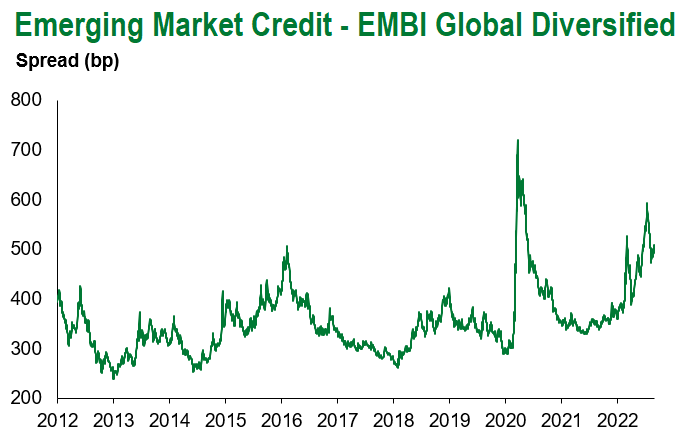
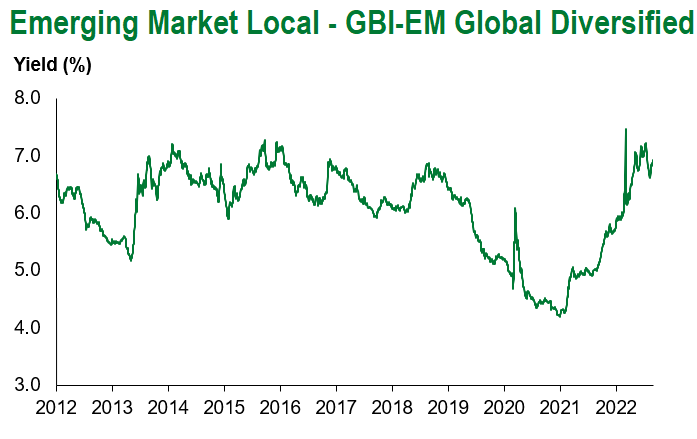
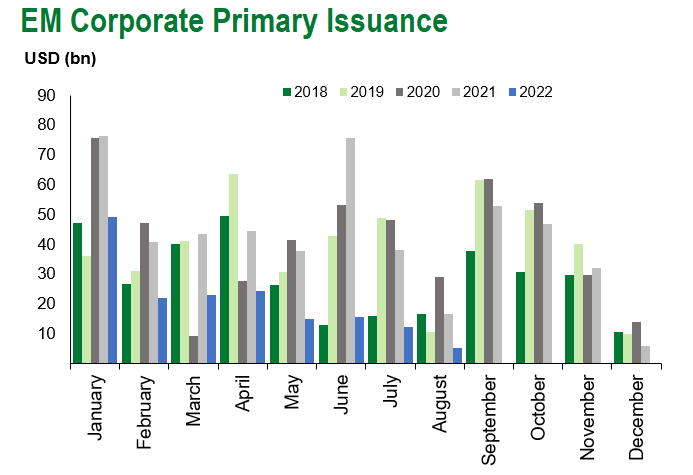
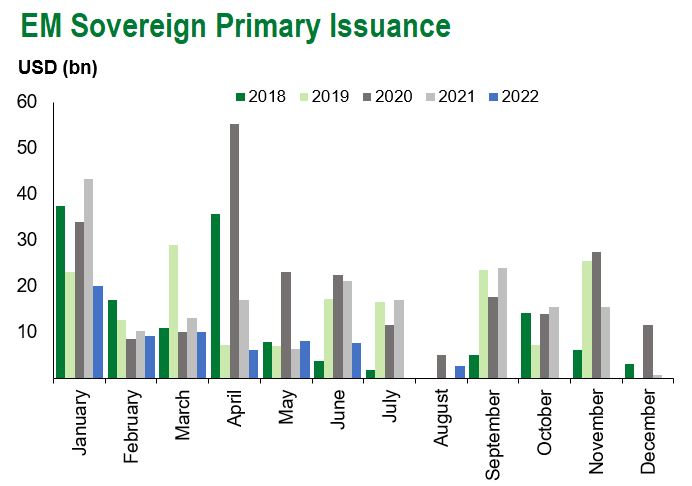
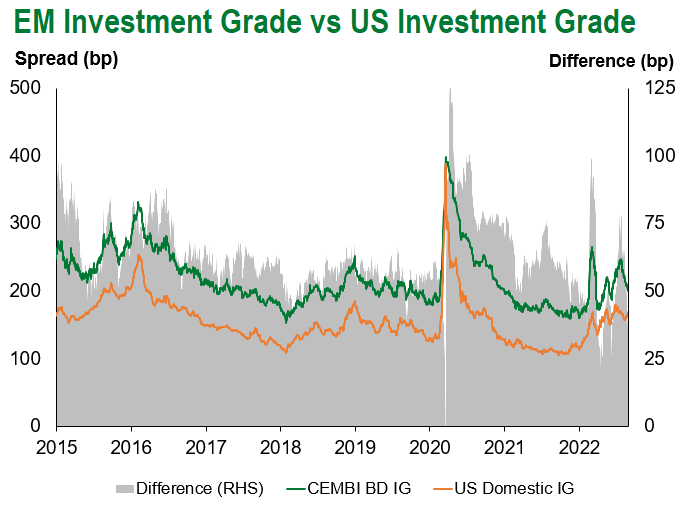
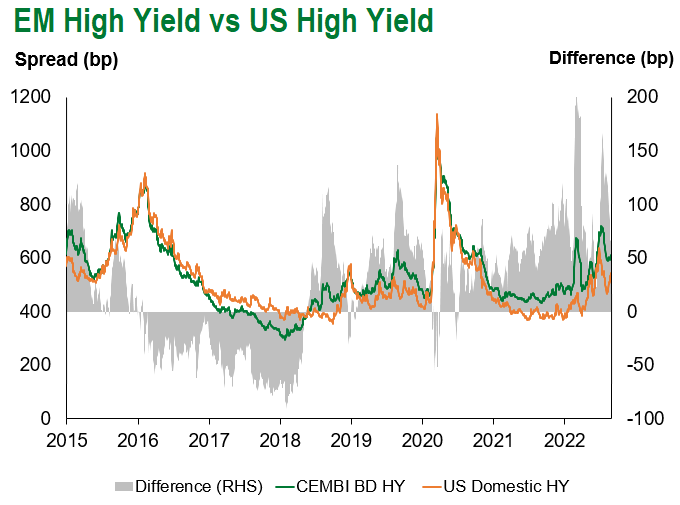
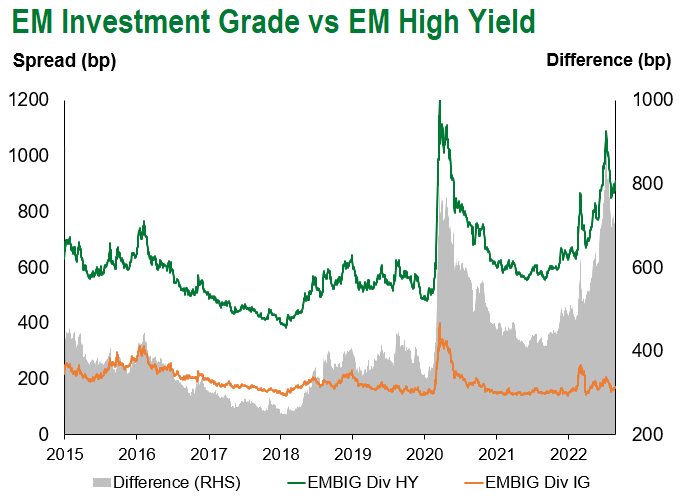
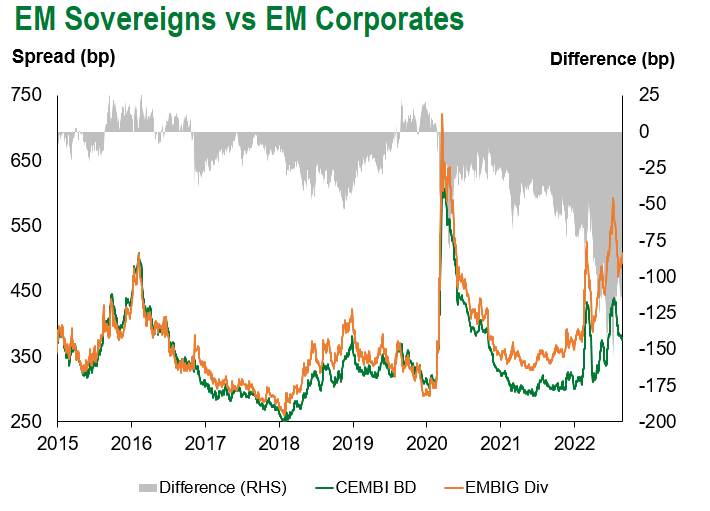
Emerging Markets Flows
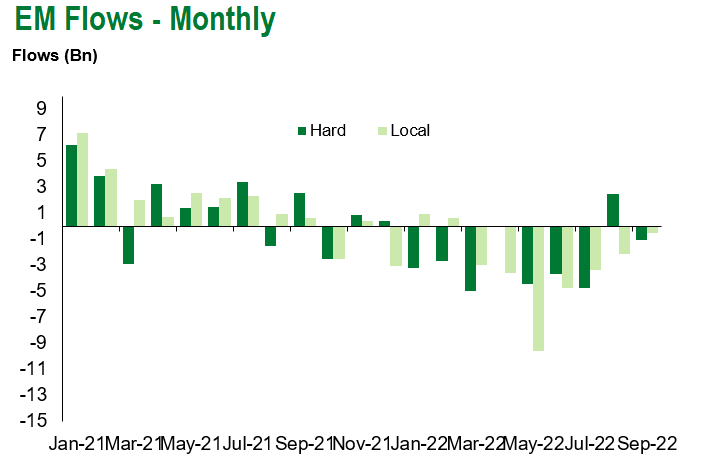
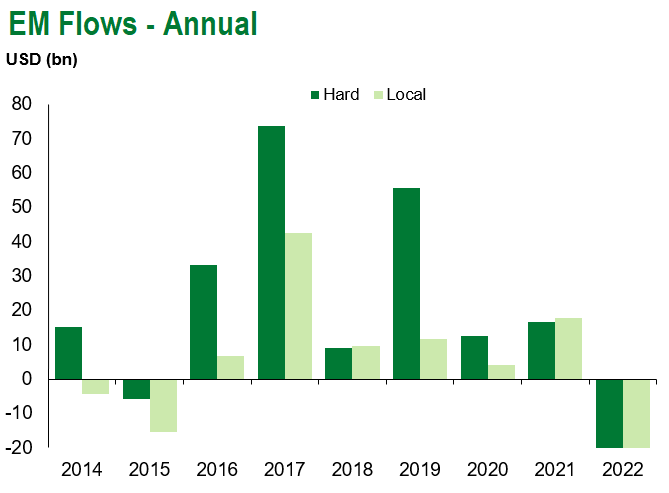
Source for graphs: Bloomberg, JPMorgan, Gramercy. As of September 2, 2022.
COVID Resources:
Johns Hopkins COVID-19 Case Tracker
For questions, please contact:
Kathryn Exum, CFA ESG, Director, Co-Head of Sovereign Research, [email protected]
Petar Atanasov, Director, Co-Head of Sovereign Research, [email protected]
James Barry, Director, Deputy Portfolio Manager, [email protected]
This document is for informational purposes only. The information presented is not intended to be relied upon as a forecast, research or investment advice, and is not a recommendation, offer or solicitation to buy or sell any securities or to adopt any investment strategy. Gramercy may have current investment positions in the securities or sovereigns mentioned above. The information and opinions contained in this paper are as of the date of initial publication, derived from proprietary and nonproprietary sources deemed by Gramercy to be reliable, are not necessarily all-inclusive and are not guaranteed as to accuracy. This paper may contain “forward-looking” information that is not purely historical in nature. Such information may include, among other things, projections and forecasts. There is no guarantee that any forecasts made will come to pass. Reliance upon information in this paper is at the sole discretion of the reader. You should not rely on this presentation as the basis upon which to make an investment decision. Investment involves risk. There can be no assurance that investment objectives will be achieved. Investors must be prepared to bear the risk of a total loss of their investment. These risks are often heightened for investments in emerging/developing markets or smaller capital markets. International investing involves risks, including risks related to foreign currency, limited liquidity, less government regulation, and the possibility of substantial volatility due to adverse political, economic or other developments. References to any indices are for informational and general comparative purposes only. The performance data of various indices mentioned in this update are updated and released on a periodic basis before finalization. The performance data of various indices presented herein was current as of the date of the presentation. Please refer to data returns of the separate indices if you desire additional or updated information. Indices are unmanaged, and their performance results do not reflect the impact of fees, expenses, or taxes that may be incurred through an investment with Gramercy. Returns for indices assume dividend reinvestment. An investment cannot be made directly in an index. Accordingly, comparing results shown to those of such indices may be of limited use. The information provided herein is neither tax nor legal advice. Investors should speak to their tax professional for specific information regarding their tax situation.
